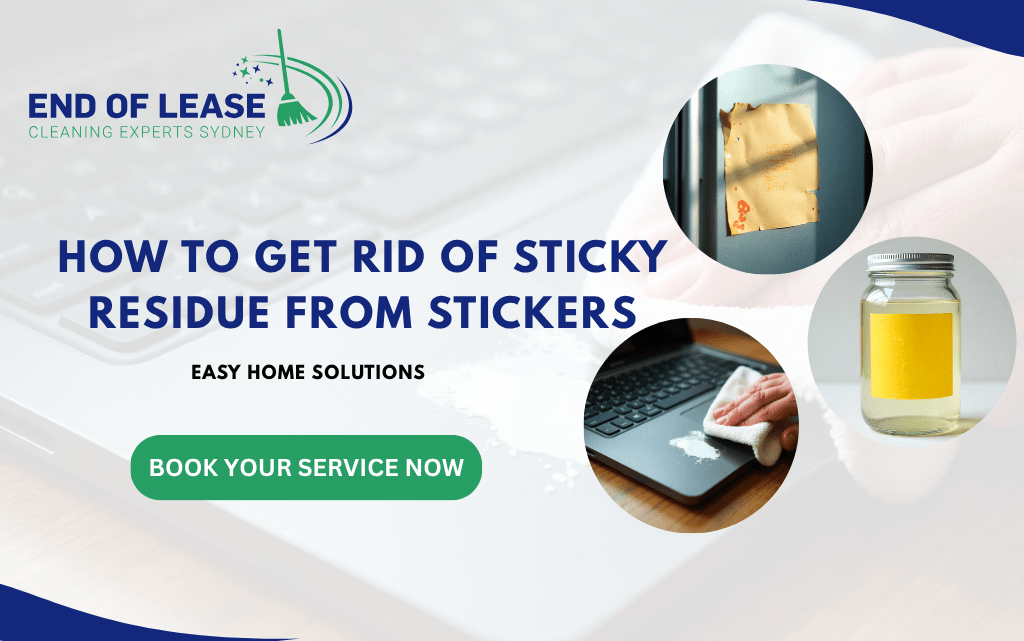That annoying sticky mess left behind after peeling off a price tag or sticker is one of the most frustrating cleaning challenges we all face. Learning how to get rid of the sticky residue from stickers doesn’t have to be complicated or expensive. The gummy adhesive seems to appear everywhere—on windows, plastic containers, wooden furniture, and even your favorite water bottle, attracting dust like a magnet and making everything look dirty and messy.
The good news is you don’t need expensive chemicals or special products to tackle this problem. You most likely already have everything you need in your kitchen cupboard to clean sticky residue and remove sticker glue. These basic household products, such as baking soda and white vinegar, are incredibly effective at eliminating sticky glue residue from nearly any surface. Whether you’re doing regular home maintenance or preparing for End of Lease Cleaning Sydney, these methods ensure spotless results. Let’s dive in and make those surfaces sparkling clean again!
Why Stickers Leave Sticky Residue
Stickers use different types of adhesives—rubber-based, acrylic, or pressure-sensitive glues. When you try to remove sticker glue, the adhesive sometimes separates from the backing and stays on your surface.
What Makes Residue Harder to Remove:
- Heat exposure: Warm places make the glue bond stronger.
- Time factor: Longer sitting time means tougher removal.
- Moisture: Humidity can make adhesives stickier.
- Surface type: What removes residue from stickers depends on the material underneath.
Different surfaces respond in different ways. Since glue doesn’t seep in, glass and metal are the easiest materials. To prevent damage, plastic needs to be handled more delicately. Wood is tricky because it absorbs adhesive, while fabric requires special care as glue seeps into fibers.
Tools and Materials You’ll Need
You won’t need to rush to the store! These natural sticker remover items are probably in your home:
- Clean clear vinegar: Dissolves adhesive naturally.
- Baking soda: Perfect for making a gentle scrubbing paste—baking soda to remove sticky residue works on almost any surface.
- Rubbing alcohol or hand sanitizer: Breaks down glue molecules quickly.
- Cooking oil or coconut oil: Safe for delicate surfaces.
- Hairdryer: Softens stubborn adhesive.
- Plastic scraper or old credit card: Lifts residue without scratching.
- Paper towels and Soft cloths: For wiping and buffing.
Safety tip: Always test on a hidden area first and avoid harsh chemicals on painted or delicate surfaces.
Step-by-Step: How to Remove Sticky Residue from Stickers
Step 1: Loosen the Adhesive
- Set your hairdryer to low or mid level of heat.
- Hold it 6 inches away and heat for 30–60 seconds.
- Gently peel off as much sticker as possible while warm.
- Heat makes the glue soft and easier to remove.
Step 2: Choose the Right Cleaning Method
For Glass & Metal:
- Apply alcohol or white vinegar to a cloth.
- Let it sit for 1 to 2 minutes.
- Wipe firmly in circular motions.
- This is the best way to remove sticky glue from glass surfaces.
For Plastic:
- Use warm soapy water first.
- If needed, try cooking oil.
- Rub gently to avoid cloudiness.
- This helps you clean sticky residue without damage.
For Wood:
- Dab cooking oil or coconut oil onto a cloth
- Rub gently in the direction of wood grain
- Never use water, vinegar, or alcohol on wood
- This safely gets sticker residue off wood without harming the finish
For Fabric:
- Apply rubbing alcohol to a cotton ball
- Dab gently on the sticky spot
- Let it sit for 2–3 minutes
- Wash afterward according to care instructions
- Perfect for cleaning sticky tape residue from fabric
Step 3: Remove Remaining Residue
- Equallt mixed all parts baking soda and cooking oil into a paste form.
- Apply to remaining sticky spots.
- Gently rub in circular motions.
- The baking soda provides gentle abrasion while oil dissolves glue.
- Wipe away with a damp cloth.
Step 4: Clean and Polish
- Wipe with warm, soapy water.
- Rinse with a clean, damp cloth.
- Dry thoroughly with a soft towel.
- Polish glass or metal with a microfiber cloth for extra shine.
Learn More: How to Remove Adhesive Residue from Glass, Plastic, and Metal
Natural Home Remedies
- Vinegar: White vinegar is an amazing natural sticker remover. The acetic acid dissolves adhesive bonds naturally. Soak a cloth in vinegar, place it on the sticky spot for a minute, and wipe clean. It’s completely safe for glass, metal, and most plastic surfaces.
- Baking Soda + Oil: Using baking soda to remove sticky residue mixed with oil creates the perfect combination. Mix them into a paste and gently scrub—this natural sticker remover works on heavy-duty residue that other methods can’t touch.
- Lemon Oil: Lemon oil cuts through grease and adhesive while leaving a fresh, clean scent. A few drops on a cloth will remove sticky residue beautifully.
- Peanut Butter: The oils in peanut butter loosen sticky glue effectively. Spread a thin layer, wait a few minutes and wipe away. Clean thoroughly afterward.
Tips to Prevent Sticker Residue
- Peel Smart: When you need to remove sticker glu. peel slowly at a 180-degree angle. Quick pulling leaves more residue behind.
- Remove Fresh Stickers: Fresh adhesive is much easier to remove sticker glue from than old, hardened gunk. Don’t let stickers age on surfaces.
- Use Heat Proactively: Warm stickers with a hairdryer for 20–30 seconds before peeling. This dramatically reduces the need to clean sticky tape residue later.
- Select detachable Labels: Selec Look for minimal adhesive or detachable labels that are made to remove sticker glue without leaving behind any residue.
When to Seek Professional Help
Sometimes DIY methods aren’t the best choice. Call experts when dealing with:
- Antique furniture or valuable items: One wrong move could cost hundreds in repairs.
- Car interiors and exteriors: Professional detailers use automotive-grade products to remove sticky glue residue safely.
- Electronics and screens: Moisture from DIY methods can damage sensitive components.
- When DIY fails: Commercial-grade solvents work on industrial-strength adhesives.
Professional cleaning might seem expensive, but it’s cheaper than replacing damaged items.
Conclusion
Now you know everything about how to get rid of the sticky residue from stickers! These methods to remove sticker glue are simple, safe, and use ingredients you already have at home. Whether you choose vinegar, baking soda, rubbing alcohol, or cooking oil, you know exactly how to clean sticky residue from any surface.
Remember to start with heat, choose the right method for your surface type, and be gentle. Prevention helps too—peel stickers slowly, remove them while fresh, and use removable labels. comfort and style. Treat it well, and it will serve your family beautifully for many years to come. For daily updates, visit to our social media channels such as Facebook, Instagram, YouTube, and Twitter. With these simple household treatments you can say goodbye to sticker muck and welcome to clean, residue-free surfaces.
FAQs About Removing Sticky Residue from Stickers
1. What’s the fastest way to remove sticker residue?
Using a hairdryer to loosen the glue, followed by rubbing alcohol or vinegar, works best for most surfaces.
2. Can vinegar damage surfaces?
Vinegar is safe for glass, metal, and plastic, but avoid using it on porous surfaces like wood or natural stone.
3. What removes sticky residue naturally?
Coconut oil, baking soda paste, or lemon essential oil are effective natural alternatives.
4. How do I remove old sticker residue that’s hardened?
Apply heat first to soften the adhesive, then use a baking soda and oil mixture or rubbing alcohol.
5. Will rubbing alcohol damage plastic?
Usually not, but it can cause dullness on some plastics. Test on a small hidden area first.
6. How can I remove sticker residue from a laptop or phone?
Use a soft cloth with a bit of rubbing alcohol or oil — never pour directly on the device.



